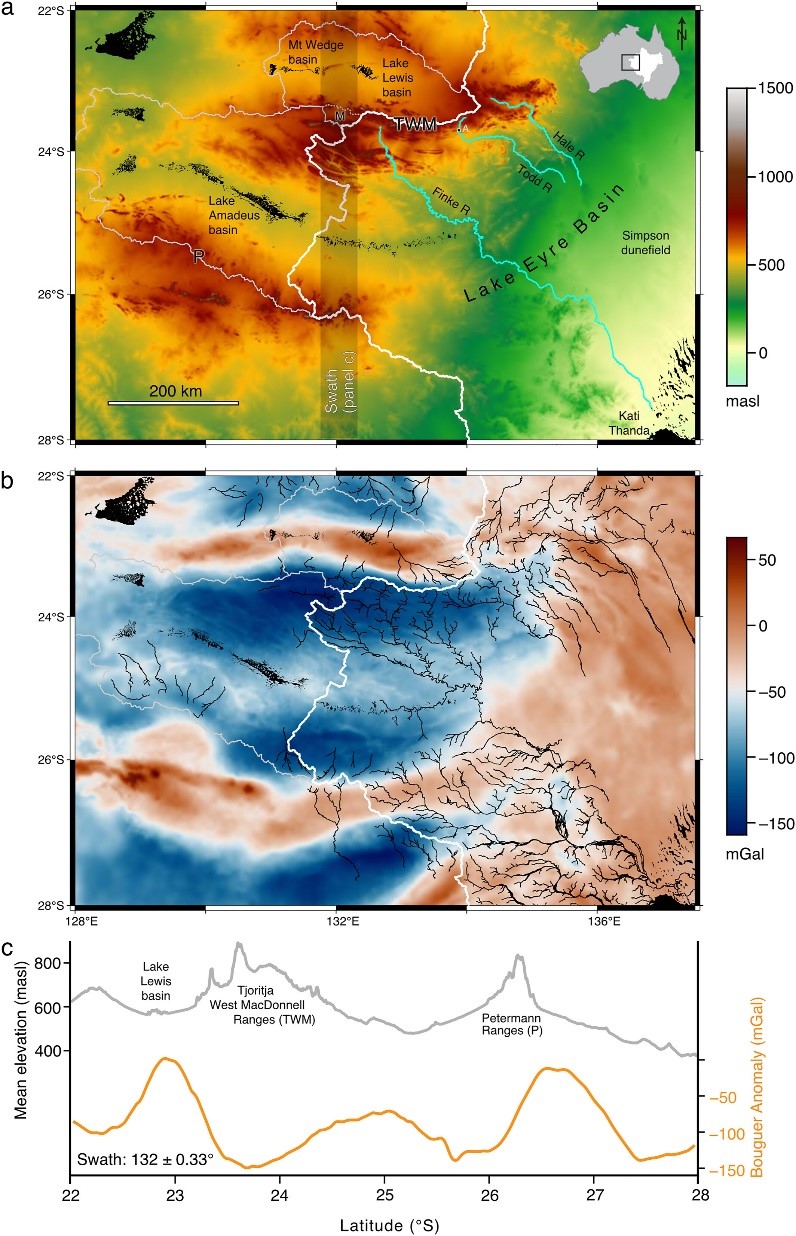Central Australia is a flat, tectonically inactive arid region with numerous internally-drained river basins. Yet, internally drained basins are a feature often associated with tectonically active environments, and thus the existence of these basins seems contradictory to the expectation of a geologically stable region. Interestingly, these basins also coincide with significant gravity anomalies caused by large loads embedded within the earth’s uppermost layer, the lithosphere, which are a relict of ancient mountain-building.
In their new paper, GFÚ researchers Gregory Ruetenik and John Jansen (Team Surface Processes & Palaeoclimate), in collaboration with Mike Sandiford (University of Melbourne, Australia) propose that transient changes in the rigidity of the lithosphere can cause deflections of the surface in the presence of these ancient loads, and influence how the landscape evolves. These changes are cyclical and driven by the fluctuating stress field within the lithosphere.
The researchers used numerical models to simulate landscape evolution under varying conditions of uplift and subsidence driven by changes in the rigidity of the lithosphere. They found that the isolation of the basins also influenced the base level (relative sea level) that the rivers are drain into. Sometimes the rivers drain to modern sea level, and sometimes they drain into an isolated basin at higher elevation. In turn, this greatly affected the dynamics of erosion within the models. The simulations successfully replicated the observed drainage patterns and basin formations, and highlight the importance of considering transience in lithosphere properties when studying landscape evolution in tectonically inactive regions.
Publication
G. A. Ruetenik, J. D. Jansen, and M. Sandiford, Surface Uplift Due To Time-Varying Elastic Thickness in Continental Interiors, Geophysical Research Letters (2024), https://doi.org/10.1029/2023GL107719

Figure 1 from publication: (a) Topographic map of central Australia; (b) Complete Bouguer anomaly gravity map, also showing the drainage network (black lines); (c) Swath of mean elevation and Bouguer anomaly (132 ± 0.33°). (G. A. Ruetenik, J. D. Jansen, and M. Sandiford, Surface Uplift Due To Time-Varying Elastic Thickness in Continental Interiors, Geophysical Research Letters (2024) https://doi.org/10.1029/2023GL107719)
Abstract
If, as previously hypothesized, the effective elastic response of the lithosphere is sensitive to the imposed stress regime, then it may vary in time and produce distinctive geomorphic responses. Such effects will be at their most crucial in landscapes of low relief. Motivated by the existence of numerous small endorheic (internally-drained) basins in central Australia, we examine the influence of changing elastic response in the presence of large embedded loads in the lithosphere underlying stable continental interiors. Focusing on the western Lake Eyre Basin and adjoining Lake Lewis basin—an area with a close correlation between drainage pattern and extreme Bouguer gravity anomalies—we devise a set of numerical simulations that incorporate the flexural response to time-transient horizontal stresses. The simulations demonstrate that transient changes in the effective elastic thickness can drive topographic changes in low-relief landscapes, including drainage capture and the development of endorheic basins, consistent with field observations.

